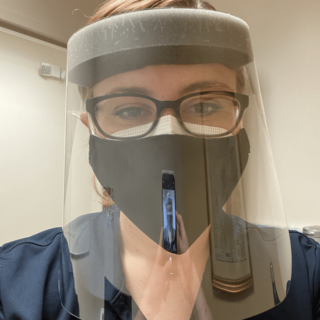Anxiety
How to Combat Mask Anxiety
Face masks can be anxiety-provoking. Here is how you can cope.
Posted June 5, 2020 Reviewed by Jessica Schrader

Face masks are officially part of our everyday lives. For some, these medical devices can be very anxiety-provoking. Here are some ways that you can cope if wearing a mask makes you anxious.
Understand the anxiety
Anxiety is not uncommon in those wearing a mask for the first time. Face mask anxiety can be worse in people with a history of an anxiety disorder (especially panic disorder) and claustrophobia.
Although you are not in a closed space, wearing a face mask can make it feel that way. The area of the face covered by the face mask is also quite sensitive to heat, and anxiety-prone people can misinterpret temperature increases as a sign of danger (Roberge, 2012). Filtration devices on most face masks also cause increased resistance to airflow, giving the illusion of breathing difficulty. This sense of breathing difficulty can provoke a flight-or-fight response that can stimulate anxiety.
Wearing a mask can also be anxiety-provoking because of what it has come to represent. Fears of illness and the discomfort of uncertainty have all risen amid this pandemic. Our masks may serve as a reminder of these uncomfortable feelings.
Remind yourself that masks are safe
Despite the fearmongering propagated by some opponents of face mask use, there is no evidence that face masks are dangerous. Standard surgical/medical masks are not to be airtight. Instead, they allow for adequate airflow around the mouth and nose, and studies have shown that their use results in no clinically significant changes in oxygen or carbon dioxide levels (Roberge, 2012). Health care professionals in the US have routinely worn masks to protect themselves and their patients since the 1920s, with no evidence that they pose any threat to the wearer (Postrel, 2020).
Challenge negative thoughts
When you find yourself thinking negative thoughts while wearing your mask, try challenging those thoughts. For example, if you have the thought, “I can’t stand wearing this!” notice that thought and tell yourself, “It might not be pleasant, but I’m wearing my mask right now and I’m OK.” Similarly, if you have the thought, “This is mask is making me so anxious, I hate it!” you could reframe that as “The mask might make me nervous, but I am glad that I’m able to do something to keep myself and others safe.”
Focus on your breathing
Try to avoid rapid, shallow breathing while you are wearing your mask. Instead, try using your diaphragm to breathe from your belly (your belly should rise and fall with your breath, rather than your chest rising and falling). Take long, slow breaths with the exhale lasting longer than the inhale. Counting the breath can help, as can practicing these sorts of breathing techniques when you aren’t wearing your mask.
Practice mindfulness
Continually work on bringing yourself back to the present. When we become anxious, it is often because our minds have drifted into the future. In doing so, we start to think about scary possibilities (for example, “What if my breath becomes shallow and I have a panic attack?” or “What will people think of me if I have to leave because my mask is so uncomfortable?”).
Notice when you have drifted into the future or past and bring yourself back to the present. Grounding techniques can be helpful. For example, try looking around the room for a certain color, noticing smells around you, or focusing on the physical sensations in your body.
Desensitize yourself
Practice makes perfect, even when it comes to reducing mask-wearing anxiety. Try wearing your mask at home for short periods, taking it off when your anxiety begins to rev up. Even if at first you are only able to wear your mask briefly, you will find longer periods more tolerable over time. Until you build up this tolerance, try limiting time spent wearing your mask outside your home. For example, complete your errands in two shorter spurts rather than one long trip.
Make it more fun and relaxing
Personalizing or otherwise decorating your face mask can make it seem less sterile and scary. People with chronic illnesses often use this as a means to relieve anxiety and make medical equipment more personable and palatable. Some people even find aromatherapy helpful when wearing a mask. You can try spritzing your mask with a scent you enjoy or one that relaxes you (as long as you don’t make the scent too overpowering).
Choose a style less likely to provoke anxiety
If you find masks made of thicker material to be more anxiety-provoking, it may help to purchase a lighter one. Ultimately, if you find that you are unable to tolerate a mask, you can ask your doctor about using a face shield instead, as recent research has shown that these can be effective in preventing the spread of COVID-19 without making you feel as restricted. Note that different mask styles may provide different levels of protection, so discuss your mask choice with your doctor if you have questions or concerns.
References
Roberge R. J., Kim, J., & Benson, S. M. (2012). Absence of consequential changes in physiological, thermal and subjective responses from wearing a surgical mask. Respir Physiol Neurobiol, 181(1), 29-35.
Postrel, V. (2020, April 10). Pandemics come and go but medical masks are eternal. Bloomberg Opinion. https://www.bloomberg.com/opinion/articles/2020-04-10/medical-face-mask…


